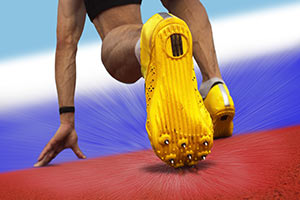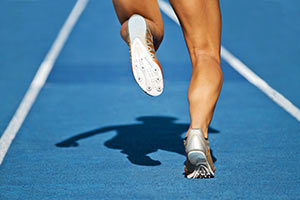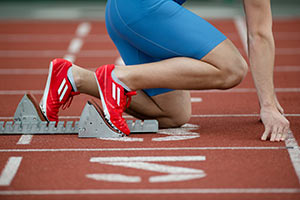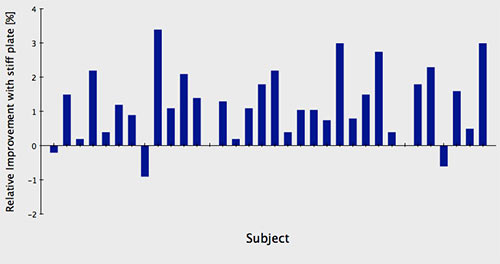
By Carl Valle
When one watches the Olympic games and sees the fastest men and women in the world, the camera always pans down to show the latest spike worn by the athletes. Each company boasts countless hours researching and designing to create the fastest shoe ever, but much of the innovation was done a 100 years ago and not much change has been done since the days of Jesse Owens, who wore a pair of Adidas sprint spikes at the 1936 Olympic games in Berlin. Most of the time when an athlete is buying a pair or athletic shoes, the questions usually revolve on how that pair of shoes, be it a cleat, sneaker, trainer, or sprint spike will make one faster. Now that barefoot training or minimalism shoes have become popular with the consumer, some interesting questions arise on how track spikes make a difference in speed, and the truth is still a bit of a mystery.
Anatomy of a Track Spike

When we see a pair of spikes we see and feel the obvious. First the actual spikes protruding from the forefoot conjures up a gripping action from the friction one may get when the foot makes contact to the track. Many coaches have wrongly believed that at top speed this gripping action of the spikes was helping athletes with a pawing action, similar to a cat swiping down and back but research and video of top sprinters refuted this idea years ago. Just looking at the track spikes one can feel that the sole is very hard, sometimes made of carbon fiber, a very hard material, and he heel is not cushioned. In fact, the heel of the track spikes is very minimal and the forefoot is angled slightly up in efforts to manipulate the metatarsophalangeal joint of (the front part of the foot) in sprinting[1]. Many believe much of the benefit of spikes are the fact they are very light, but the spikes do seem to be a visible attribute that sets them apart. Besides those main attributes, track spikes are very similar and not much different between brands and models. If one was to strip down the spikes and remove the logos, how much would one notice the difference between Nike Spikes and Puma Spikes? Would Usain Bolt have run faster if he were using a different pair of spikes? How do we test the effectiveness of Track spikes in sprinting?
Measuring Spikes and Sprinting Speed

Many times the world speed or faster come to mind when selecting a pair of track spikes, but the problem is that speed is not specific enough to illustrate how track spikes work. Speed can meet maximal speed or acceleration, and spikes have been tested in research to see how they interact with our legs and the ground with different tools in sport science. Electromyography can share how muscles are activated while sprinting. force plates can illustrate how we put power into the ground, and motion capture can show how our bodies move by measuring joint angles and other kinematic data. While those aforementioned technologies are good at explaining why we may be benefiting from spikes, most athletes just want to know one thing. How much faster will I run? A race like the 100m will have several phases where track spikes may share their impact, but track spikes mainly help with the early few steps out of the blocks. During the initial departure out of the stationary position of either a three point start in football combines or block starts in track and field, a lot of forces are going backwards in order to go forwards. Anyone slipping on wet grass during acceleration will appreciate cleats over a smooth soled sneaker, and this is where most of the contributions are in the actual spikes. One can make a good case that the removable spikes prevent slips or errant movements rather than being an performance aid.
What Sport Science Discovered with Track Spikes and Speed

Countless studies on foot mechanics and performance have been done, but the best and most straightforward investigation is seeing if one simply runs faster with different shoes, specifically the track spike models we use now and lesser options. Studies ranging from barefoot testing, different spike plates, and even different types of tracks ranging form soft to hard, and even “springy” options have been testing. What was found was not surprising, but spikes are better than barefoot for producing speed and several theories based on the variables they tested. Not only did the researchers time the sprints to see the difference in speed with electronic timing, they actually looked at the motion of the foot in amazing detail to see what precisely was the cause of the improvement. What was found is the hardness of the plate increased the performance, and while some may think that horizontal forces from the friction of spikes matter, one must rethink the value when athletes are able to sprint across ice rinks at full speed as seen on Ken Jakalski’s video.
In 1968 Puma and Adidas were in a spike war with both promoting a brush style spike with dozens of tiny spikes. The benefit of the amount of spikes is negligible and the real reason they were banned was because the rules didn’t permit the changes and the IAAF still bans more than 11 spikes currently. Full speed running is maximal velocity mechanics meaning more vertical forces are being placed on the ground up and down rather than behind the athlete. What we can conclude is that spikes have three roles. The first is obvious, being light enough not to slow down the leg when it’s swinging in the air and this has not been a problem for 50 years as the weight hasn’t been that heavy in the past. Legs being repositioned isn’t a limiting factor in the research, but nobody plans to compete in construction boots as most shoes now are light weight. Second is the need for a shoe that is hard to help transmit forces through the track. When athletes come to tracks, many can observe the hardness by dropping a ball and seeing how high it bounces back. Athlete want a hard track in competition, and the same rules apply with a hard spike. Cushioning is good perhaps for training with distance runners, but when it comes to speed, hard options rule, but to a limit.
The Spike Test Results
In the study Increased Shoe Bending Stiffness Increases Sprint Performance, the researchers concluded that a hard plate is necessary to improving spike performance, but not all athletes respond the same to increasing the stiffness of the spike plate. Some barely got better and some got slower, but most improved their speed. What the researchers did was timed the athletes in a 40 meter sprint and analyzed the 20-40 m segment. What they found was some athletes improved by a few hundredths when wearing harder track spikes, specifically the soles that were made of carbon fiber[2].

Figure 1. Relative improvement of track spike with stiff plate.
The main lesson learned is that each athlete is very individual and sport scientists don’t know all there is to designing the perfect spike shoe. With many athletes wondering what the right shape and size of the removable spikes themselves are the right ones, it’s better to focus on how the entire spike works in practice with timing and using different models that are not creating any specific soreness int the foot besides the usual aches of training. It is true that barefoot sprinting is different mechanically than wearing spikes, but one is giving up s statistical significance if one decides to go barefoot or minimalist shoe. Wearing spikes all the time may not be a good idea from a health perspective, but competing and doing fast workouts with them is a compromise that is a must if one wants to be competitive. What we do know is that spikes do change the way the joints of the foot work, but the performance advantages are worth anything that may occur unnaturally[3].
How to pick the right pair of spikes
Each year when the various shoe catalogs come out, athletes rush to see the latest developments in spikes and most of the changes are in fact cosmetic , not functional. When we see the latest spike model, we usually see a new strip of material here, a change in pattern there, but the spike is going to be nearly the same as the previous year when you remove the style components. Most spikes being similar because the variables are limited to weight, hardness, and limited spike distribution, that comfort is important and they should feel good on the body when sprinting. Most athletes except of the most elite sprinter will not have customized spikes based on the shape and function of the foot, so different pairs should be experimented with. Some athletes benefit with some minor insertions of different materials like a pad or thin orthotics, but keep in mind the competition is wearing the same options so the true advantage is not likely to be coming from spike use. Whatever spike one is choosing, the key is not expecting an advantage over the competition, but the necessary advantage of choosing to have one instead of using a regular athletic shoe. If one is believing that a specific model is going to give them an advantage over another athlete, then one may want to rethink that strategy a little since most modern spikes are so similar that not much difference is going to manifest in races. Find a spike that works for you, and just remember to look for hard options that are lightweight.
Please share this article so others may benefit.
[mashshare]Related Topics
8 Tips for Selecting Track Spikes
References
- Jason B. Krell & Darren J. Stefanyshyn (2006) The relationship between extension of the metatarsophalangeal joint and sprint time for 100 m Olympic athletes, Journal of Sports Sciences, 24:2, 175-180, DOI: 10.1080/02640410500131621
- Darren Stefanyshyn & Ciro Fusco (2004) Increased Shoe Bending Stiffness Increases Sprint Performance, Athletics, Sports Biomechanics, 3:1, 55-66, DOI: 10.1080/14763140408522830
- Smith G, Lake M, Less A (2013) Metatarsophalangeal Joint Function During Sprinting: A Comparison of Barefoot and Sprint Spike Shod Foot Conditions, Journal of Applied Biomechanics, ahead of print.

